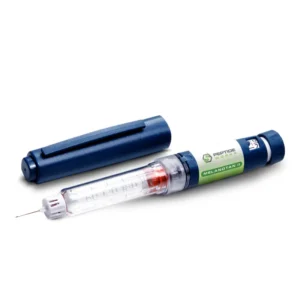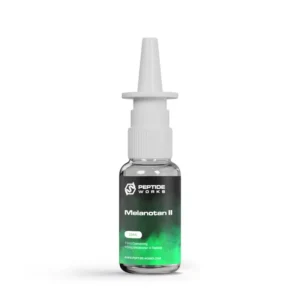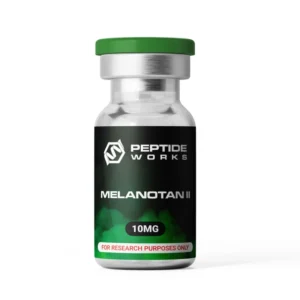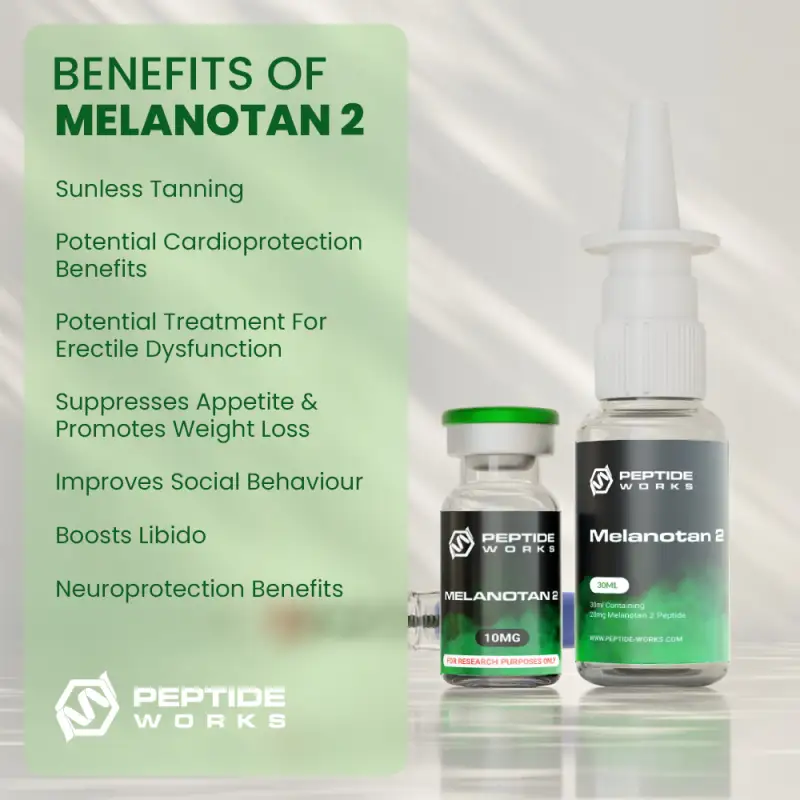PROMO!
First order? Get 10% OFF with this code: 1storder
Our Product Categories



Melanotan 2 or MT2 is a synthetic analog of the naturally occurring peptide hormone called alpha-melanocyte-stimulating hormone (α-MSH). It was originally developed to explore its potential in treating skin conditions like erythropoietic protoporphyria and vitiligo.
MT2 is best known for its role in stimulating melanogenesis, the natural process through which the body produces melanin, the pigment that determines the color of our skin, hair, and eyes. This peptide has also been studied for its effects on sexual function, appetite regulation, and energy homeostasis.
Peptide Sequence (IUPAC Condensed): Ac-Nle-Asp(1)-His-D-Phe-Arg-Trp-Lys(1)-NH2
Molecular Formula: C50H69N15O9
Molecular Weight: 1024.2 g/mol
Synonyms: MT-2
View the Melanotan 2 COA
View the Melanotan 2 HPLC

Melanotan 2 works by attaching to melanocortin receptors in your body (specifically MC1R, MC3R, MC4R, and MC5R receptors). These receptors are part of a system that controls different body functions. Its main job is to target the MC1R receptor in skin cells called melanocytes. This then boosts the production of eumelanin, which is a pigment. This process increases skin tanning, helps protect against UV rays, and lowers the risk of DNA damage.
MT2 also affects sexual arousal and erectile function through the MC4R receptor in the central nervous system. This has led to research exploring its potential as a treatment for sexual dysfunction. It also influences appetite and energy regulation, though these particular effects are not yet fully characterized.
Skin Pigmentation: Research suggests that Melanotan 2 enhances skin pigmentation and promotes sunless tanning by stimulating melanocyte proliferation and melanin production [1].
Clinical studies show that low doses of MT-II administered subcutaneously result in noticeable tanning within days, even without UV exposure. MT-II increases the expression of melanogenic proteins like tyrosinase, boosting pigmentation [2].
Erectile Function and Sexual Desire: Research has shown that Melanotan 2 enhances erectile function and sexual desire by activating melanocortin (MC) receptors in the brain and spinal cord. Clinical studies show MT-II significantly increases penile rigidity and erection duration in men with erectile dysfunction, even those with organic risk factors. It also boosts sexual desire compared to placebo [3].
MT-II’s effects are mediated through central melanocortinergic pathways, with supraspinal and spinal mechanisms playing key roles. Side effects include nausea and yawning, but its potent erectogenic and desire-enhancing properties highlight its potential as a therapeutic option for erectile dysfunction and disorders of sexual desire [4].
Appetite Suppression: Research indicates that MT-II suppresses appetite and promotes fat loss by targeting melanocortin receptors (MC2R and MC5R) involved in lipolysis. Studies show MT-II reduces food intake in a dose-dependent manner and leads to sustained body mass reduction and lower adiposity, even after appetite normalizes [5].
MT-II stimulates fat breakdown in adipocytes through pathways involving ERK1/2 and AMPK. These findings highlight MT-II’s potential as a long-term modulator of energy balance and a promising tool for obesity management [6].
Treating Alcoholism and Cravings: Research suggests that MT-II shows potential in reducing alcoholism and cravings by targeting melanocortin receptors (MC3/MC4R) in the brain. Studies reveal MT-II decreases alcohol intake, particularly in alcohol-preferring rats, while increasing water consumption [7].
Studies have shown it also synergistically enhances the effectiveness of naltrexone (NAL), a common treatment for alcohol abuse, in reducing binge drinking. By modulating melanocortin and opioid systems, MT-II offers a promising therapeutic approach for managing alcohol cravings and improving existing alcohol abuse treatments [8].
[1] Z Abdel-Malek, V B Swope, I Suzuki, C Akcali, et al (1995) Mitogenic and melanogenic stimulation of normal human melanocytes by melanotropic peptides. – Proc Natl Acad Sci U S A, 1995 Feb 28, Volume 92 (Issue 5), Pages 1789–1793.
[2] R T Dorr, R Lines, N Levine, C Brooks, et al (1996) Evaluation of melanotan-II, a superpotent cyclic melanotropic peptide in a pilot phase-I clinical study – Life Sciences, 1996, Volume 58 (Issue 20), Pages 1777-84.
[3] H Wessells, V J Hruby, J Hackett, et al (2006) MT-II Induces Penile Erection via Brain and Spinal Mechanisms – Annals of the NT Academy of Sciences, Volume 994 (Issue 1), THE MELANOCORTIN SYSTEM, June 2003, Pages 90-95.
[4] H Wessells 1, D Gralnek, R Dorr, et al (2000) Effect of an alpha-melanocyte stimulating hormone analog on penile erection and sexual desire in men with organic erectile dysfunction – Urology, 2000 Oct 1, Volume 56 (Issue 4), Pages 641-6.
[5] C Laustrup Møller, K Raun, M Lambert Jacobsen, et al (2011) Characterization of murine melanocortin receptors mediating adipocyte lipolysis and examination of signalling pathways involved – Molecular and Cellular Endocrinology, 2011 Jul 20, Volume 341 (Issues 1-2), Pages 9-17.
[6] I Côté, Y Sakarya, N Kirichenko, et al (2016) Activation of the central melanocortin system chronically reduces body mass without the necessity of long-term caloric restriction – Canadian Journal of Physiology & Pharmacology, 2016 Oct 19, Volume 95 (Issue 2), Pages 206–214.
[7] D A York, S Boghossian, and M Park-York (2011) Melanocortin activity in the amygdala influences alcohol intake – Pharmacology, Biochemistry & Behavior, 2011 Mar, Volume 98 (Issue 1), Pages 112-9.
[8] M Navarro, F Carvajal, J M Lerma-Cabrera, et al (2015) Evidence that Melanocortin Receptor Agonist Melanotan-II Synergistically Augments the Ability of Naltrexone to Blunt Binge-Like Ethanol Intake in Male C57BL/6J Mice – Alcoholism, Clinical & Experimental Research, 2015 Aug, Volume 39 (Issue 8), Pages 1425-33.
The answers to the most frequently asked questions about Melanotan 2.

Buy Melanotan 2 Peptide Nasal Spray from Peptide Works. Supplied in 15ml and 30ml glass spray bottles, this non-invasive administration route for research offers a convenient and effective way to ensure consistent use.
Melanotan-2 may influence libido by activating melanocortin receptors in the brain linked to sexual function. In research settings, this peptide has shown an ability to trigger arousal responses in animal and early human studies. The effect is not consistent or approved for clinical use. Melanotan-2 remains a research compound, not a therapeutic product.
Melanotan-2 has been studied for its effects on sexual function because it activates melanocortin receptors involved in arousal and erection. Research shows it can cause spontaneous erections in some studies, suggesting biological activity. However, these responses have not led to any approved medical use, and more research is needed to understand its potential role in erectile function.
Melanotan-2 and PT-141 come from the same peptide family but act differently. Melanotan-2 mainly increases melanin production, leading to skin tanning and sometimes influencing sexual response as a side effect. PT-141 was later designed to target receptors linked only to sexual function, not pigmentation. In short, Melanotan-2 affects tanning and libido, while PT-141 focuses solely on arousal pathways.
Melanotan-2 is supplied strictly for laboratory research. In the United States, it is not approved by the FDA for human or medical use, and regulations limit its sale to research purposes only. Laws differ across countries what may be allowed for research in one region can be restricted or prohibited in another. Always follow local guidelines before purchasing research materials.

This blog explores peptide tanning, a scientific approach to enhancing skin pigmentation without sun exposure. It examines how peptides like Melanotan 1 and 2 stimulate melanin production, their unique effects and their role in pigmentation research. Learn about their benefits, mechanisms and potential for safer, controlled tanning solutions.

This blog explores the potential influence of Melanotan 2 peptide on oxytocin signaling and its broader implications for neurobehavioral research. It delves into how Melanotan 2 interacts with melanocortin receptors, potentially affecting stress, bonding and social behaviors, including autism related deficits. The article highlights emerging research and the peptide's role in understanding brain and hormone pathways.

This blog explores the differences between Melanotan 1 and Melanotan 2, two peptides known for enhancing tanning by stimulating melanin production. It discusses their mechanisms, receptor activity, effects, and possible side effects to help researchers understand their potential in pigmentation, metabolism, and other related areas. A helpful guide for making informed research decisions!
ALL CONTENT AND PRODUCT INFORMATION AVAILABLE ON THIS WEBSITE IS FOR EDUCATIONAL PURPOSES ONLY.
DISCLAIMER: These products are intended solely as a research chemical only. This classification allows for their use only for research development and laboratory studies. The information available on our Peptide Works website: https://peptide-works.com/ is provided for educational purposes only. These products are not for human or animal use or consumption in any manner. Handling of these products should be limited to suitably qualified professionals. They are not to be classified as a drug, food, cosmetic, or medicinal product and must not be mislabelled or used as such.